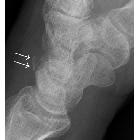Triquetrumfraktur
























Triquetral fractures are carpal bone fractures generally occuring on the dorsal surface of the triquetrum. The triquetral may be fractured by means of impingement from the ulnar styloid, shear forces, or avulsion from strong ligamentous attachments. They are the second commonest carpal bone fracture, after the scaphoid.
Pathology
The usual injury mechanism is falling onto an outstretched hand in ulnar deviation. Less commonly, it may be caused by a direct blow to the dorsum of the hand, a situation where commonly other carpal fractures are seen.
Radiographic features
There are three fracture patterns often observed, dorsal avulsion fractures, triquetral body fractures and volar avulsion fractures .
Dorsal avulsion fracture
On plain film, dorsal avulsion injuries are best detected on a lateral projection, where typically an avulsed flake of bone is identified lying posteriorly to the triquetral bone (see pooping duck sign). CT or MR may be more sensitive than conventional radiographs for detection of avulsion injuries.
Triquetral body fracture
Triquetral body fractures appear as clear fracture lines through the body, they are best seen on the oblique projection of the wrist, although cross sectional imaging may be required to further elucidate extent.
Volar avulsion fractures
Volar avulsion fractures are avulsions of the palmar ulnar triquetral/lunotriquetral ligament and are best seen on a radial deviation projection of the wrist .
Treatment and prognosis
Surgical intervention is rarely required, but a persistently symptomatic chip fracture may require excision.
Differential diagnosis
Imaging differential considerations include:
Siehe auch:

 Assoziationen und Differentialdiagnosen zu Triquetrumfraktur:
Assoziationen und Differentialdiagnosen zu Triquetrumfraktur:


